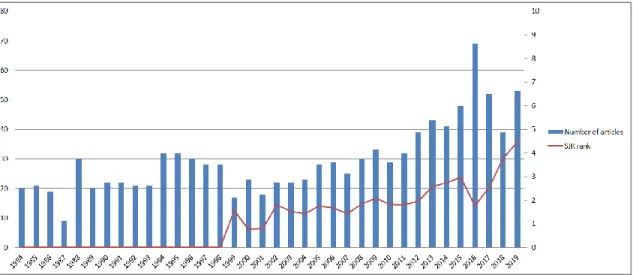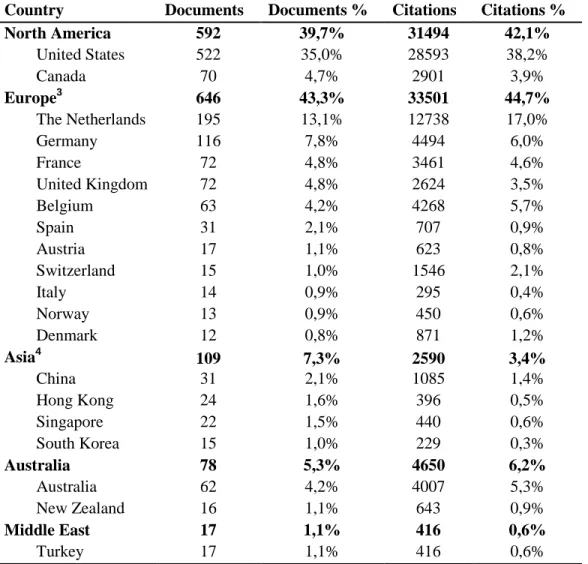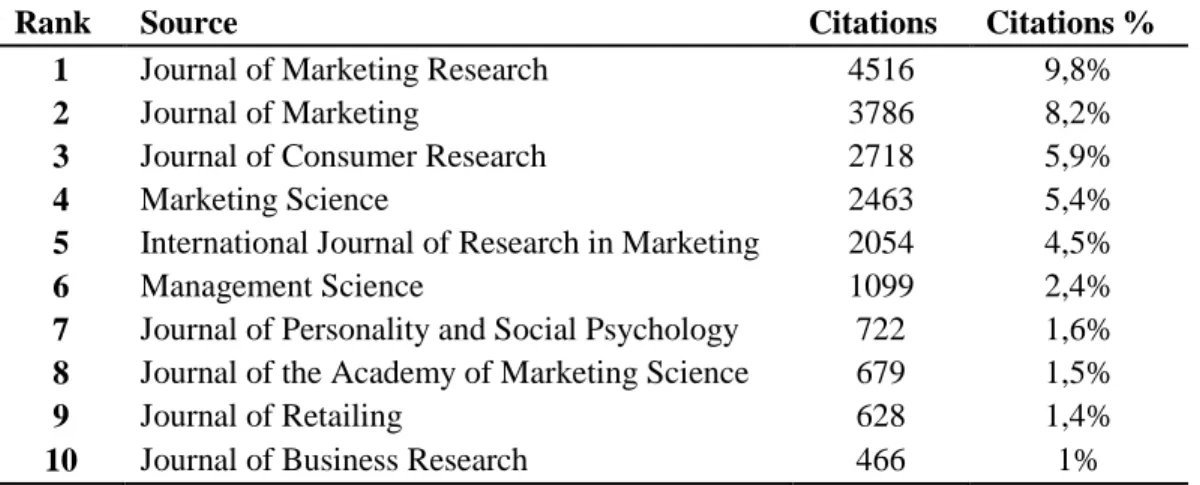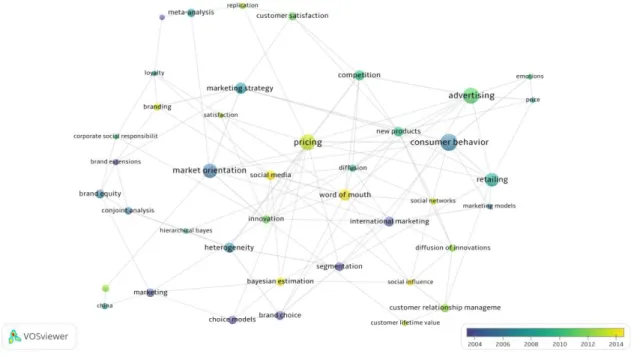HAL Id: hal-03006191
https://hal.archives-ouvertes.fr/hal-03006191
Submitted on 15 Nov 2020HAL is a multi-disciplinary open access archive for the deposit and dissemination of sci-entific research documents, whether they are pub-lished or not. The documents may come from teaching and research institutions in France or abroad, or from public or private research centers.
L’archive ouverte pluridisciplinaire HAL, est destinée au dépôt et à la diffusion de documents scientifiques de niveau recherche, publiés ou non, émanant des établissements d’enseignement et de recherche français ou étrangers, des laboratoires publics ou privés.
International Journal of Research in Marketing: A
systematic review from its foundation in 1984 until
2019, using bibliometric analysis
Stephanie Nguyen
To cite this version:
Stephanie Nguyen. International Journal of Research in Marketing: A systematic review from its foundation in 1984 until 2019, using bibliometric analysis. 49th EMAC Annual Conference, Budapest 2020, May 2020, Budapest, Hungary. �hal-03006191�
1
International Journal of Research in Marketing: A systematic review from its
foundation in 1984 until 2019, using bibliometric analysis
Stephanie Nguyen *
Aix Marseille Univ, CERGAM, IAE Aix, Aix-en-Provence, France Stephanie.Nguyen@iae-aix.com
2
International Journal of Research in Marketing: A systematic review from its
foundation in 1984 until 2019, using bibliometric analysis
Abstract:
This study explores the literature published in the International Journal of Research in Marketing, the official journal of the European Marketing Academy (EMAC), from 1984 until 2019. Our systematic review is based on the bibliometric analysis of a set of 1064 articles, published by 1753 authors across 46 countries. Leveraging different analyses, we are able to provide a better understanding of the journal’s knowledge structure. First, using bibliographic coupling, we highlight the most productive and influential countries and authors, confirming that the journal includes, as originally intended, a majority of studies originating from Europe. Second, based on citation analysis, we identify the main journals influencing its foundations. Finally, with co-occurrence analysis, we uncover the major research trends, namely consumer behavior,
advertising, pricing, market orientation, and retailing. To conclude, we discuss some advantages and limitations of the bibliometric methodology.
Keywords: bibliometric analysis; international journal of research in marketing; VOSviewer
3 1. Introduction
The International Journal of Research in Marketing (IJRM), the official journal of the
European Marketing Academy (EMAC), focuses on marketing contributions from different
disciplinary approaches and is aimed at an international forum of marketing academics and practitioners. The journal encourages research that is innovative, visionary or path breaking. The first issue of the IJRM was published in 1984, and its first Editor at the time was Berend
Wierenga (Wierenga, 2008). The current Editor-in-Chief since 2018 is PK Kannan, from the University of Maryland (Kannan, 2018), he succeeds to Roland Rust who remained three years as the journal’s Editor (Rust, 2018). The journal has recently reached the thousand publications milestone and celebrated its 35th anniversary, and as such, it seems timely to propose a
retrospective analysis (Martínez-López, Merigó, Valenzuela-Fernández, & Nicolás, 2018). As the data set constituted by all the IJRM publications is very large, containing over a thousand
publications, we propose to use for this literature review a bibliometric methodology, which is based on a quantitative approach of bibliographical elements (Zupic & Čater, 2015).
The review starts with the analysis of the yearly publication trend of the IJRM and provides several insights. First, throughout its 35 years of existence, the IJRM has published a total of 1064 articles, representing an average of 30 articles per year. The number of articles published each year went as low as 9 publications in 1987, and as high as 52 articles in 20171. The IJRM
Figure 1. Publication trend and SJR rank of the International Journal of Research in Marketing
1
Note that while 69 articles were published in 2016, 18 correspond to a special section issued from the 2014 conference, Theory + Practice in Marketing
4 publication trend since 1984 is presented in Figure 1, and also includes the evolution of the SJR, the SCImago Journal Rank, a well-recognized index used to evaluate academic journals’ impact and influence. Two periods can be distinguished: before and after 2011. From 1984 until 2011, the IJRM published on average 24.5 articles each year. Then starting in 2012, the publication trend has started to increase significantly and is up to 45 articles per year on average.
2. Literature Review
Bibliometric analysis can be used to describe, evaluate and monitor published research. This method is not new (Price, 1976), but recently, it has become more popular and easier to perform with the digitization of sources by online databases, such as Web of Science and Scopus, along with the development of specific software for conducting bibliometric analysis, for
example BibExcel (Zupic & Čater, 2015) or VOSviewer (Van Eck & Waltman, 2009). The bibliometric methodology relies on the social network theory, where members exchange valued resources. In the case of a bibliometry, articles citing each other constitute a social network in which knowledge is the valued resource and references are the medium of exchange.
Bibliometric methods have been used to study the knowledge published in a specific research domain, for example luxury research (Gurzki & Woisetschläger, 2017), or international marketing (Samiee & Chabowski, 2012). Bibliometrics can also be leveraged to analyze the publication trend of an author, an institution, or, in our case, a specific journal. Several
bibliometric overviews of well-established journals have already been published, including one of the Journal of Business Research (Merigó, Mas-Tur, Roig-Tierno, & Ribeiro-Soriano, 2015), and one of the European Journal of Marketing (Martínez-López et al., 2018).
Using a bibliometric methodology has several advantages: (1) it is comprehensive and permits the analysis of a large number of publications, in our case a little over a thousand articles; it is also a way to include in the review process all types of studies, quantitative as well as
qualitative, conceptual and empirical research, contrary to meta-analysis for example, mostly based on quantitative findings; (2) it is objective, as opposed to conceptual reviews, that are more subjective as they depend on the researchers’ interpretations, choices, and even biases; (3) it does not consider authors independently or isolated from one another but rather takes into
consideration a pattern of relationship between them; (4) it is empirical and systematic hence reproducible.
5 In this study we intend to leverage different types of bibliometric analyses and show how they can complement each other. We will use bibliographic coupling (1), citation (2) and co-occurrence analysis (3). Bibliographic coupling (1) considers the references two publications have in common as a measure of similarity between them: the more cited references they share, the stronger their connection. As references shared between documents remain unchanged, bibliographic coupling is static. Another type of analysis is based on co-citations (2): two authors are considered as being co-cited when they appear conjointly in the reference list of a subsequent article. When authors co-occur in the references list, it can be interpreted as a form of relatedness. Co-citations are dynamic: they develop and change overtime along with new publications and their citation patterns. Finally, a third type of analysis, the co-occurrence analysis (3), uses publications’ textual data, such as keywords, titles or abstracts, and calculates the number of occurrences of the different terms as well as their co-occurrences.
As a bibliometric analysis starts with collecting the publications, in the next section we first explain our choice with regards to the database, then we detail our data collection process.
3. Methodology
Existing studies use either Scopus or Web of Science to collect their data. In our case, Scopus was an easy decision because Web of Science only references articles of the IJRM since 1997, representing a set of 683 articles, while Scopus is more exhaustive, referencing all the IJRM publications since 1984, which corresponds to a set of 1064 articles. With regards to the data collection process, we filtered based on the journal’s name (“Source Title”). The search query returned 1165 documents out of which we excluded (based on “Document Type”) 64 Editorials, 20 Notes, 11 Erratum, 5 Undefined and 1 Letter, keeping a set of 1064 articles2. Finally, we decided to use VOSviewer for our analysis because it has been shown to provide a more satisfactory representation of bibliometric datasets, compared to well‐ known
multidimensional scaling (MDS) approaches (van Eck, Waltman, Dekker, & van den Berg, 2010).
4. Results
4.1. Most Productive and Influential Countries
2
6 First, we performed a bibliographic coupling analysis on the country-level, selecting the full counting method (as opposed to fractional counting). Out of 46 countries contributing to the IJRM, we selected the most productive, using the cut-off criteria of 10 publications.
Country Documents Documents % Citations Citations %
North America 592 39,7% 31494 42,1% United States 522 35,0% 28593 38,2% Canada 70 4,7% 2901 3,9% Europe3 646 43,3% 33501 44,7% The Netherlands 195 13,1% 12738 17,0% Germany 116 7,8% 4494 6,0% France 72 4,8% 3461 4,6% United Kingdom 72 4,8% 2624 3,5% Belgium 63 4,2% 4268 5,7% Spain 31 2,1% 707 0,9% Austria 17 1,1% 623 0,8% Switzerland 15 1,0% 1546 2,1% Italy 14 0,9% 295 0,4% Norway 13 0,9% 450 0,6% Denmark 12 0,8% 871 1,2% Asia4 109 7,3% 2590 3,4% China 31 2,1% 1085 1,4% Hong Kong 24 1,6% 396 0,5% Singapore 22 1,5% 440 0,6% South Korea 15 1,0% 229 0,3% Australia 78 5,3% 4650 6,2% Australia 62 4,2% 4007 5,3% New Zealand 16 1,1% 643 0,9% Middle East 17 1,1% 416 0,6% Turkey 17 1,1% 416 0,6%
Table 1. Most productive and influential countries published in the IJRM from 1984 until 2019 The United States is the largest contributor of the IJRM, totaling 35% of all the
publications; along with Canada, their authorship represents 40% and their influence, as measured by the number of citations, is slightly over 42%. Despite the important role of North America, Europe remains the most important contributor, both from a quantitative aspect (43.3% of articles) as well as a qualitative perspective (44.7% of citations). In Europe, the Netherlands is
3
Sweden, Ireland, Finland, Greece, Portugal, Czech Republic, Hungary and Poland don’t appear because they don’t meet the 10-publications threshold.
4
7 the most productive country from far, generating over 13% of the IJRM articles and receiving 17% of the citations. Germany is the second-biggest European contributor with close to 8% of the contributions along with 6% of the citations. Then France, the United Kingdom and Belgium come in third position, with each, on average, 4.6% of the publications and 4.6% of the citations. Asia and Australia’s contribution is much lower, but remains significant, respectively with 7.3% and 5.3% of the articles, 3.4% and 6.2% of the citations. Finally, the Middle East and South America appear underrepresented, with a handful of publications (less than ten), and receiving only a marginal number of citations (less than 1%).
4.2. Most Productive and Influential Authors
Second, we performed a bibliographic-coupling analysis on the author-level, selecting the full counting method. Out of 1753 authors contributing to the IJRM, we selected the 10 most productive and the most influential authors, based on their number of publications and their number of citations. Table 2 presents our results for the top 10 authors; authors appearing in both rankings are in italic, and their affiliated country (based on their university) is in parentheses. Rank Productive Authors Articles Rank Influential Authors Citations
1 Steenkamp JB (USA) 20 1 Steenkamp JB (USA) 4291
2 Leeflang PSH (NL) 19 2 Bagozzi RP (USA) 2078
3 Wittink DR (USA) 16 3 Dholakia UM (USA) 1785
4 Dekimpe MG (NL) 14 4 Baumgartner H (USA) 1784
5 Bijmolt t.h.a.(NL); Gijsbrechts E (NL) 13 5 Rangaswamy A (USA) 1497
6 Kamakura WA (USA); Verhoef PC (NL) 12 6 Geyskens I (NL) 1349
7 Stremersch S (NL) 11 7 Pearo LK (USA) 1159
8 Muller E (USA); Mahajan V (USA); Lilien GL (USA); Wedel M (NL)
10 8 Kumar N (CH) 1134
9 Rangaswamy A (USA); Warlop L (NO);
Currim IS (USA); Lehmann DR (USA)
9 9 Rossiter JR (AU) 1131
10 Bagozzi RP (USA); Baumgartner H (USA);
Wierenga B (NL); Skiera B; (DE) Clement M (DE)
8 10 Reinartz W (DE) 1033
Table 2. Most productive and influential authors published in the IJRM from 1984 until 2019 Steenkamp clearly emerges as the most productive but more importantly, the most cited author, hence he can be considered as the most influential author of the IJRM. His most cited article is a methodological paper on the use of Lisrel in the context of validating marketing constructs (Steenkamp & van Trijp, 1991); his second most cited article is a transatlantic study on
8 trust and commitment (Geyskens, Steenkamp, Scheer, & Kumar, 1996). A quick calculation shows that he received as much as 3.5% of all citations made in the IJRM (4291 citations out of a total of 121427 citations). As a matter of comparison, Steenkamp received more than twice as many citations as the second-ranked author, Bagozzi, whose most cited article proposes a model for virtual community participation (Dholakia, Bagozzi, & Pearo, 2004). Furthermore, this analysis confirms our previous conclusions, based on the country-level analysis: when looking at these authors’ universities, we see that they represent universities from the Netherlands (Erasmus, Tilburg, and Groningen) and universities from the United States (Penn state, Pennsylvania, Michigan, Rice, and NYU), which are the two most productive and the most influential countries of the IJRM.
4.3. Influential Journals Cited in the International Journal of Research in Marketing
Third, we performed a co-citation on the source-level, selecting the full counting method. Out of a total of 10421 sources (i.e., journals) referenced in the IJRM, we selected the ten most cited sources.
Rank Source Citations Citations %
1 Journal of Marketing Research 4516 9,8%
2 Journal of Marketing 3786 8,2%
3 Journal of Consumer Research 2718 5,9%
4 Marketing Science 2463 5,4%
5 International Journal of Research in Marketing 2054 4,5%
6 Management Science 1099 2,4%
7 Journal of Personality and Social Psychology 722 1,6% 8 Journal of the Academy of Marketing Science 679 1,5%
9 Journal of Retailing 628 1,4%
10 Journal of Business Research 466 1%
Table 3. Main journals cited by the IJRM from 1984 until 2019
Co-citation analysis takes into account all the references made by our set of articles: in total, VOSviewer calculated that the set of 1064 articles cited 46002 references from 10421 sources (i.e., journals), representing an average of 43 references per article. Out of those citations, the most cited journals are the Journal of Marketing Research, receiving almost 10% of all
citations, and the Journal of Marketing, with 8.2% of the citations. Then, behind, the Journal of Consumer Research collects 5.9% of the citations and Marketing Science has 5.4% of the
9 citations. Interestingly, out of the top ten journals, seven journals are focused on marketing, one journal is in psychology (the Journal of Personality and Social Psychology), and finally two journals, are in the general business and management category (Management Science and the Journal of Business Research), receiving respectively 2.2% and 0.9% of the citations. Hence with the help of co-citation analysis, we are able to understand that the structure of the literature influencing the IJRM knowledge is heavily focused on marketing. It is also based on the literature in general business and management research, as well as psychology.
4.4. Main Research Themes
Finally, we performed a co-occurrence analysis based on the articles’ keywords, selecting the full counting method (as opposed to fractional counting) where each co-occurrence has the same weight. Out of a total of 2596 keywords, the cut-off criterion we selected is at least six occurrences, resulting in a set of 43 keywords.
Figure 2. IJRM articles' top keywords mapping and clustering from 1984 until 2019
VOSviewer maps the keywords in such a way that the size of the circles corresponds to the number of occurrences for each keyword, and the lines along with the distance between the keywords (i.e., circles) correspond to the number of publications in which they co-occur together. Figure 2 presents the cartography of those keywords for our set of 1064 articles, with a threshold of six occurrences. On the map, the largest circles correspond to the top keywords, those used the
10 most often throughout our data set. In our case, Consumer Behavior (1), Advertising (2), Pricing (3), Market orientation (4) and Retailing (5) appear as the top research themes investigated in the IJRM. It is possible to propose a finer-grained analysis by selecting a lower threshold, for
example at least three occurrences instead of six.
Finally, using bibliometrics can also help to find future research avenues. For example, by identifying topics that may be under-represented in the journal’s literature but are considered as important by the IJRM, based on the journal’s positioning and scope of research. In our review, the keyword communication is not part of our set of 43 keywords, but if communication is considered as an important research avenue by the editorial team of the IJRM, then a more detailed analysis can be conducted, in order to find the extent to which this topic is addressed by the journal. If indeed it appears as underrepresented, then the journal can decide to promote it by announcing a call for papers dedicated to this specific stream of research. Furthermore, as the lines linking the circles on the map represent keywords’ co-occurrences, their presence (or lack thereof) also provides an additional source of information, related to topics being studied conjointly (or not being studied conjointly).
5. Conclusions and Limitations
This study contributes to the literature on bibliometrics and showcases that it is a powerful methodology to analyze large sets of data. With bibliometrics, it is possible to perform analysis on the macro-level (in our case over one thousand documents published across 35 years), as well as the meso-level (in this study looking into countries’ and authors’ contributions), and down to the micro-level (when counting each word’s occurrences). Furthermore, one of the main purposes of the IJRM when it was created was to “publish work from all different countries and in
particular, pay attention to research done in the various European countries”. Our analysis reveals that the majority of articles are indeed authored by European countries, which confirms that the IJRM continues to reach its goal throughout its 35 years of academic publications.
Our review also has some limitations. The first limit concerns the actual size constraints for our paper, as there are many additional insightful analyses that could have been performed on our data set. For example, by distinguishing different timespans (such as decades), it’s possible to look into the temporal evolution of the IJRM and better understand the development of different research trends over time. Another limit of this type of study is that they highly depend on
11 the databases will be included in the bibliometric analysis and because these databases are
privately owned, this raises some questions with regards to researchers’ autonomy and independence from private interests.
References
Dholakia, U. M., Bagozzi, R. P., & Pearo, L. K. (2004). A social influence model of consumer participation in network- and small-group-based virtual communities. International
Journal of Research in Marketing, 21(3), 241–263.
Geyskens, I., Steenkamp, J.-B. E. M., Scheer, L. K., & Kumar, N. (1996). The effects of trust and interdependence on relationship commitment: A trans-Atlantic study. International
Journal of Research in Marketing, 13(4), 303–317.
Gurzki, H., & Woisetschläger, D. M. (2017). Mapping the luxury research landscape: A bibliometric citation analysis. Journal of Business Research, 77, 147–166.
Kannan, P. K. (2018). A Message from the Incoming Editor. International Journal of Research in
Marketing, 35(4), 536–537.
Martínez-López, F. J., Merigó, J. M., Valenzuela-Fernández, L., & Nicolás, C. (2018). Fifty years of the European Journal of Marketing: a bibliometric analysis. European Journal of
Marketing, 52(1/2), 439–468.
Merigó, J. M., Mas-Tur, A., Roig-Tierno, N., & Ribeiro-Soriano, D. (2015). A bibliometric overview of the Journal of Business Research between 1973 and 2014. Journal of
Business Research, 68(12), 2645–2653.
Price, D. de S. (1976). A general theory of bibliometric and other cumulative advantage processes. Journal of the American Society for Information Science, 27(5), 292–306. Rust, R. T. (2018). Editorial: Reflections on the review process. International Journal of
Research in Marketing, 35(4), 533–535.
Samiee, S., & Chabowski, B. R. (2012). Knowledge structure in international marketing: a multi-method bibliometric analysis. Journal of the Academy of Marketing Science, 40(2), 364– 386.
Steenkamp, J.-B. E. M., & Van Trijp, H. C. M. (1991). The use of lisrel in validating marketing constructs. International Journal of Research in Marketing, 8(4), 283–299.
Van Eck, N. J., Waltman, L., Dekker, R., & van den Berg, J. (2010). A comparison of two techniques for bibliometric mapping: Multidimensional scaling and VOS. Journal of the
American Society for Information Science and Technology, 61(12), 2405–2416.
Van Eck, N. J., & Waltman, L. (2009). Software survey: VOSviewer, a computer program for bibliometric mapping. Scientometrics, 84(2), 523–538.
Wierenga, B. (2008). The International Journal of Research in Marketing (IJRM): Its conception and early years. International Journal of Research in Marketing, 25(3), 149–150. Zupic, I., & Čater, T. (2015). Bibliometric methods in management and organization.




